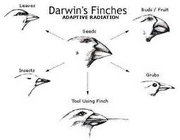
H. bolina- The blue moon butterfly, very recently was on the brink of extinction.
Evolution is a process that occurs usually over billions of years. For some species who can reproduce at rapid rates, however, evolution, or change in a species, can occur over much shorter periods.
Blue Moon Butterfly: Also known as H. bolina, found commonly in Australia and New Zealand. This striking insect has been attacked by the Wolbachia parasite, a reproductive manipulator, causing every male off-spring to die during embryonic phases, and thereby quickly destroying the species (Duplouy & O'Neil, 2010). This devastating infestation did not stop the butterfly from managing to evolve it's way out of the reproductive predicament. Not only did the butterfly genetically mutate into a Wolbachia resistant species, but it was able to evolve at an extremely fast pace, the fastest rate scientists have been able to document thus far. Taking just ten generations to successfully mutate into a butterfly species that could survive and resist common parasitic conditions( Duplouy & O'Neil, 2010). This positive evolutionary fight is encouraging for the fate of other insect species that are threatened by other environmental factors.[]
Darwins Finches
http://beam.berkeley.edu/sites/default/files/Darwins_Finches.pdf
Above is a link for a lesson plan to teach about accelerated evolution. This is an egaging lesson that would be great for a middle school or high school classroom. Materials needed are cheap and easily accessible!
